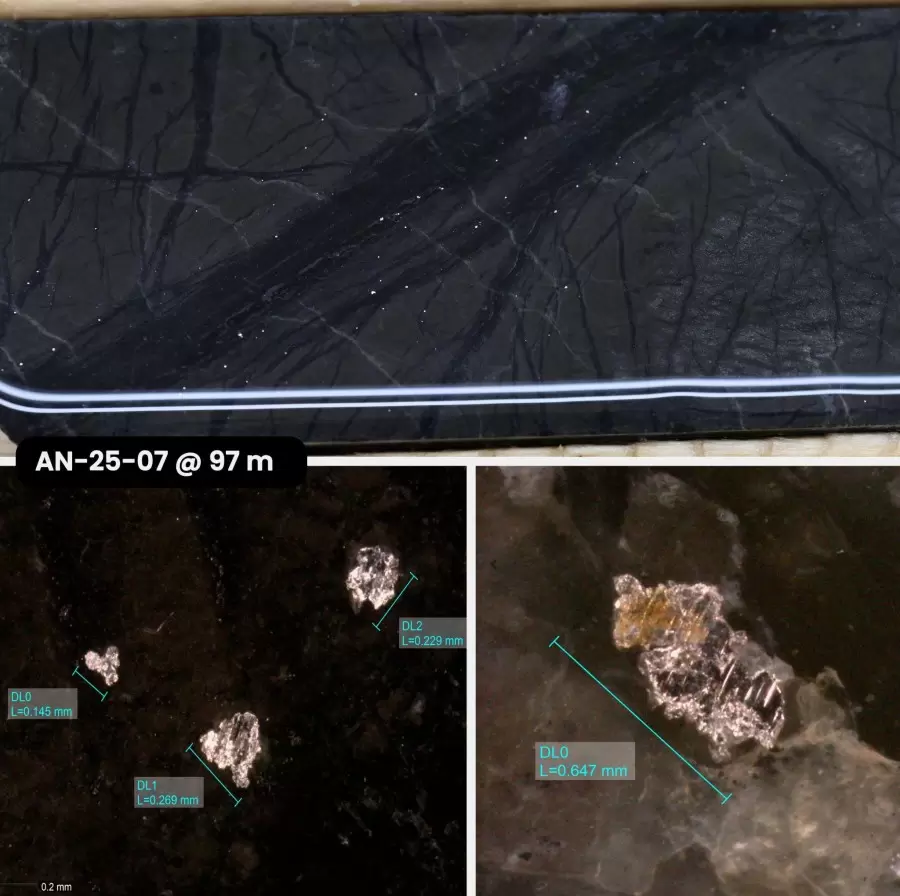First Atlantic Nickel Expands RPM Zone with Significant Awaruite Discovery
First Atlantic Nickel (TSXV: FAN; OTCQB: FANCF; FSE: P21) has announced a major expansion of its RPM Zone at the Atlantic Nickel Project in central Newfoundland, following new drill results that confirm substantially increased dimensions of awaruite mineralization.
The company’s second hole from its Phase 2 drill program, AN-25-07, has expanded the known width of the RPM Zone to 750 meters, representing a 50% increa
...
First Atlantic Nickel Expands RPM Zone with Significant Awaruite Discovery
First Atlantic Nickel (TSXV: FAN; OTCQB: FANCF; FSE: P21) has announced a major expansion of its RPM Zone at the Atlantic Nickel Project in central Newfoundland, following new drill results that confirm substantially increased dimensions of awaruite mineralization.
The company’s second hole from its Phase 2 drill program, AN-25-07, has expanded the known width of the RPM Zone to 750 meters, representing a 50% increase from the previously established 500-meter width. The hole intersected visibly disseminated awaruite grains throughout a 495-meter section, ending in mineralization.
“We congratulate our geological team on the breakthrough discovery at the RPM Zone,” stated Adrian Smith, CEO of First Atlantic Nickel. “Prior operators conducting exploration at the Pipestone Ophiolite Complex missed the awaruite mineralization in the southern parts of the property, where our team’s systematic approach and unique experience recognized both the geological controls and the distinction between surface expressions and underlying mineralization.”
The RPM Zone is now confirmed to measure approximately 750 meters wide by 400 meters long, with mineralization traced to depths of up to 495 meters. Every hole drilled in the zone has intersected large-grain, visibly disseminated awaruite, a naturally occurring nickel-iron-cobalt alloy.
AN-25-07 was drilled as a 400-meter step-out north from the initial discovery line, demonstrating strong continuity of awaruite mineralization along strike. The company has since completed two additional holes (AN-25-08 and AN-25-09) on a further northern line, extending the tested north-south strike length to 800 meters.
The Phase 2 drilling program aims to test a strike length beyond 1 kilometer, potentially establishing a substantial bulk-tonnage nickel resource within the company’s 100%-owned Atlantic Nickel Project, which spans a 30-kilometer district-scale area in Newfoundland.
Metallurgical testing to date has shown promising results. Drilling at the RPM Zone has returned magnetically recoverable nickel averaging 1.38% in magnetic concentrate, with a mass pull of 9.08%. This results in an average Davis Tube Recovery (DTR) nickel grade of 0.12% and overall recovery of 51.59% from an average starting grade of 0.24% over 1,763 meters of continuously sampled core.
The mineral awaruite (Ni₃Fe) represents a potentially revolutionary advancement in nickel production. As noted by the United States Geological Survey in 2012: “The development of awaruite deposits in other parts of Canada may help alleviate any prolonged shortage of nickel concentrate. Awaruite, a natural iron-nickel alloy, is much easier to concentrate than pentlandite, the principal sulfide of nickel.”
Unlike conventional nickel sulfide or laterite ores, awaruite can be processed through magnetic separation alone, eliminating the need for energy-intensive smelting, roasting, or acid leaching processes. This characteristic addresses a critical bottleneck in the North American nickel supply chain – limited smelting capacity – while also avoiding environmental challenges such as acid mine drainage that often complicate the permitting of sulfide ore projects.
The average nickel content of awaruite (approximately 76%) significantly exceeds that of common nickel-bearing minerals like pentlandite, which typically contain around 25% nickel. This high-grade potential, combined with its favorable processing profile, positions awaruite as a strategic mineral for clean energy and battery metals supply chains.
In parallel with drilling at RPM, First Atlantic Nickel is conducting district-scale prospecting across the broader Pipestone Ophiolite Complex. Numerous surface rock samples containing visible awaruite have been collected and are undergoing both assay and DTR metallurgical testing to identify additional mineralized zones beyond RPM.
Smith highlighted Newfoundland’s streamlined permitting process as a key advantage, noting that the company has “advanced from discovery to Phase 2 drilling significantly faster than would have been possible in many other jurisdictions.”
The RPM Zone is situated 10 kilometers south of the company’s Super Gulp Zone and 26 kilometers south of the historical Atlantic Lake Zone, indicating the potential for multiple deposits across the property.
No resource estimate has yet been published for the RPM Zone, and further drilling will be required to fully define the scale and grade of mineralization before economic assessments can be conducted. The company expects to provide additional updates on Phase 2 drilling and other project developments in the coming weeks.



14 Comments
The 30km district-scale potential is massive. If they can replicate this success elsewhere, it’s a huge win.
The 30km district-scale potential is massive. If they can replicate this success elsewhere, it’s a huge win.
The 30km district-scale potential is massive. If they can replicate this success elsewhere, it’s a huge win.
The 30km district-scale potential is massive. If they can replicate this success elsewhere, it’s a huge win.
The 30km district-scale potential is massive. If they can replicate this success elsewhere, it’s a huge win.
The 30km district-scale potential is massive. If they can replicate this success elsewhere, it’s a huge win.
The 30km district-scale potential is massive. If they can replicate this success elsewhere, it’s a huge win.
The 30km district-scale potential is massive. If they can replicate this success elsewhere, it’s a huge win.
The 30km district-scale potential is massive. If they can replicate this success elsewhere, it’s a huge win.
The 30km district-scale potential is massive. If they can replicate this success elsewhere, it’s a huge win.
The 30km district-scale potential is massive. If they can replicate this success elsewhere, it’s a huge win.
The 30km district-scale potential is massive. If they can replicate this success elsewhere, it’s a huge win.
The 30km district-scale potential is massive. If they can replicate this success elsewhere, it’s a huge win.
The 30km district-scale potential is massive. If they can replicate this success elsewhere, it’s a huge win.